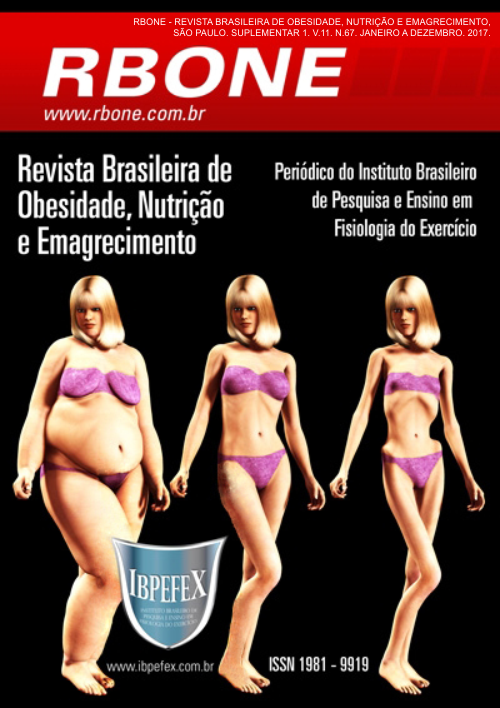Nutritional semiology of cancer patients hosted at a philanthropic institution in the interior of Bahia
Abstract
Introduction: Cancer is a process of uncontrolled and widespread growth of cells, responsible for thousands of deaths in the world. Breast cancer is the most frequent and the highest incidence among Brazilian women and the risk factors for its development are linked to endocrine factors, genetics and age; Already for cancer in the digestive tract, the risk factors are numerous, but the most frequent are related to inadequate eating habits, obesity, physical inactivity, alcohol consumption and smoking. Aim: To evaluate the dietary profile and the quality of life in patients assisted by a nursing home in the interior of Bahia. Methodology: This is a cross-sectional study where the dietary profile and quality of life of breast cancer patients and cancer in the digestive tract were investigated through the application of descriptive questionnaires. Results: Most interviewees had low family income, low educational level and average age 58.4 years. 63.3% of the sample were diagnosed with breast cancer and the most commonly used treatment was radiotherapy. In relation to the symptomatology, the most reported was difficulty feeding. For the quality of life factor, a median value was observed and the food frequency questionnaire indicated low consumption of preventive foods for the neoplasia and 46.7% of the population was overweight. Conclusion: The results of the research demonstrate that the diet is becoming less healthy, which may contribute to the increased incidence of cancer.
References
-Brito, L.F.; Silva, L.S.; Fernandes, D.D.; Pires, R.A.; Nogueira, A.D.R.; Souza, C.L.; Cardoso, L.G.V. Perfil nutricional de pacientes com câncer assistidos pela casa de acolhimento ao paciente oncológico do sudoeste da Bahia. Revista Brasileira de cancerologia. Vol. 58. Núm. 2. p. 163-171. 2012.
-Brasil. Ministério da Saúde. Vigilância alimentar e nutricional -Sisvan: orientações básicas para a coleta, o processamento, a análise de dados e a informação em serviços de saúde. 2004. Disponível em: <http://bvsms.saude.gov.br/bvs/publicacoes/orientacoes_basicas_sisvan.pdf> Acesso em 28 agos. 2017.
-Chow, E.; Hird, A.; Velikova, G. Eortc Quality of Life Group; Collaboration for Cancer Outcomes Research and Evaluation. The European Organization for Research and Treatement of Cancer Quality of Life Questionnaire for patients with bone metastases: the EortcQLQ-BM22. Eur J Cancer. Vol. 45. Núm. 7. p. 1146-1152. 2009.
-Garófolo, A.; Avesani, C. M.; Camargo, K. G.; Barros, M. E.; Silva, S. R.J.; Taddei, J. A. A. C.; Sigulem, D.M. Dieta e câncer: um enfoque epidemiológico. Rev. Nutr. Vol. 17. Núm. 4. p. 491-505. 2004.
-Gonçalves, L.L.C.; Lima, A.V.; Brito, E.S.; Oliveira, M.M.; Oliveira,L.A.B.;Abud, A.C.F. Fatores de risco para câncer de mama em mulheres assistidas em ambulatório de oncologia. Revista de enfermagem. Vol. 18. Núm. 3. p. 468-472. 2010.
-Gonzalez, M.C.; Borges, L.R.; Silveira, D.H.; Assunção, M.C.F.; Orlandi, S.P. Validação da versão em português da avaliação subjetiva global produzida pelo paciente. Rev Bras Nutr Clin. Vol. 25. Núm. 2. p. 102-108. 2010.
-Holtan, S. G.; O'connor, H. M.; Fredericksen, Z. S.Food-frequency questionnaire-based estimates of total antioxidant capacity and risk of non-Hodgkin lymphoma. International Journal of Cancer. Vol. 131. Núm. 5. p. 1158-1168. 2012.
-Instituto Nacional de Câncer. Estimativa 2012: Incidência de Câncer no Brasil. Rio de Janeiro: INCA. 2011.
-Instituto Nacional de Câncer. ABC do câncer. Rio de Janeiro: INCA. 2012.
-Instituto Nacional de Câncer. Programa Nacional de controle de Mama. Rio de Janeiro: INCA. 2013.
-Instituto Nacional de Câncer. Estimativa 2014: Incidência de câncer no Brasil. Rio de Janeiro: INCA. 2014.
-Instituto Nacional de Câncer. Estimativa 2016: Incidência de Câncer no Brasil. Rio de Janeiro: INCA. 2015.
-Instituto Nacional de Câncer. Estimativa. 2016. Disponível em: <http://www2.inca.gov.br/wps/wcm/connect/inca/portal/home> Acesso em 20/12/2016.
-Lipschitz, D.A. Screening fornutritional status in the elderly. Primary Care. Vol. 21. Núm. 1. p. 55-67. 1994.
-Machado, S.M.; Sawada, N.O. Avaliação da qualidade de vida de pacientes oncológicos em tratamento quimioterápico adjuvante. Texto & Contexto -Enfermagem. Vol. 17. Núm. 4. p. 750-757. 2008.
-Nascimento, F.S.M.; Góis, D.N.S.; Almeida, D.S.; Nascimento, A.L.; Almeida, T.C.; Guedes, V.R. A importância do acompanhamento nutricional no tratamento e na prevenção do câncer. Ciências Biológicas e de Saúde Unit. Vol. 2. Núm. 3. p. 11-24. 2015.
-Sampaio, H.A.C.; Rocha, D.C.; Sabry, M.O.D.; Pinehiro, L.G.P. Consumo alimentar de mulheres sobreviventes de câncer de mama: análise em dois períodos de tempo. Rev. Nutr. Vol. 25. Núm. 5. p. 597-606. 2012.
-Silva, P.B.; Lopes, M.; Trindade, L.C.T.; Yamanouchi, C.N. Controle dos sintomas e intervenção nutricional. Fatores que interferem na qualidade de vida de pacientes oncológicos em cuidados paliativos. Rev Dor. Vol. 11. Núm. 4. p. 282-288. 2010.
-World Health Organization. Quality of Life Assessment (WHOQOL): position taper from the World Helth Organization. Soc Sci Med. Vol. 41. Núm. 10. p.1403-1409. 1995a.
-World Cancer Research Fund (USA). Food, nutrition, physical activity, and the prevention of cancer: A global perspective. Washington (DC): American Institute for Cancer Research; 2007.
-World Health Organization. Expert Committee: physical status: the use and interpretation of anthropometry. Geneva, 1995b. Technical Report Series, n. 854. b
-World Health Organization. Estados Unidos; 2012. Disponível em: <http://globocan.iarc.fr/Default.aspx>
Authors who publish in this journal agree to the following terms:
- Authors retain the copyright and grant the journal the right of first publication, with work simultaneously licensed under the Creative Commons Attribution License BY-NC which allows the sharing of the work with acknowledgment of the authorship of the work and initial publication in this journal.
- Authors are authorized to enter into additional contracts separately for non-exclusive distribution of the version of the work published in this journal (eg, publishing in institutional repository or book chapter), with acknowledgment of authorship and initial publication in this journal.
- Authors are allowed and encouraged to post and distribute their work online (eg, in institutional repositories or on their personal page) at any point before or during the editorial process, as this can bring about productive change as well as increase impact and impact. citation of published work (See The Effect of Free Access).






